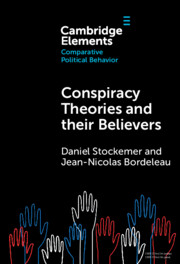Refine search
Actions for selected content:
70 results
10 - Imagined Communities and Imaginary Plots
-
- Book:
- Nationalism as a Way of Life
- Published online:
- 11 December 2025
- Print publication:
- 11 December 2025, pp 282-302
-
- Chapter
- Export citation
General anxiety, political anxiety, and support for conspiracy theories
-
- Journal:
- Politics and the Life Sciences , First View
- Published online by Cambridge University Press:
- 24 November 2025, pp. 1-9
-
- Article
-
- You have access
- Open access
- HTML
- Export citation
Conspiracy Stories
-
- Journal:
- Canadian Journal of Philosophy , FirstView
- Published online by Cambridge University Press:
- 14 October 2025, pp. 1-19
-
- Article
-
- You have access
- Open access
- HTML
- Export citation
Epilogue
-
- Book:
- Türkiye, Iran, and the Politics of Comparison
- Published online:
- 21 September 2025
- Print publication:
- 09 October 2025, pp 251-265
-
- Chapter
- Export citation
Fighting the Cabal from the Diet: Sanseitō and the Role of Conspiracy as Political Ideology
- Part of
-
- Journal:
- Asia-Pacific Journal / Volume 23 / 2025
- Published online by Cambridge University Press:
- 24 September 2025, e14
-
- Article
-
- You have access
- Open access
- HTML
- Export citation
9 - Conspiracy Theories and Violent Extremism
- from Part II - Individual-Level Perspectives
-
-
- Book:
- The Cambridge Handbook of the Psychology of Violent Extremism
- Published online:
- 31 October 2025
- Print publication:
- 07 August 2025, pp 166-184
-
- Chapter
- Export citation
Between myth and reality: the modern underground reception of Michael Psellos
-
- Journal:
- Byzantine and Modern Greek Studies / Volume 49 / Issue 2 / October 2025
- Published online by Cambridge University Press:
- 06 August 2025, pp. 292-309
- Print publication:
- October 2025
-
- Article
-
- You have access
- Open access
- HTML
- Export citation
Chapter 10 - Extreme Overvalued Beliefs
- from Section 2 - Confounding Factors and Special Populations
-
-
- Book:
- A Clinical and Forensic Guide to Cults and Persuasive Leadership
- Published online:
- 19 June 2025
- Print publication:
- 03 July 2025, pp 170-185
-
- Chapter
- Export citation
9 - “Do Your Own Research”
-
-
- Book:
- Governing Misinformation in Everyday Knowledge Commons
- Published online:
- 13 March 2025
- Print publication:
- 20 March 2025, pp 188-213
-
- Chapter
-
- You have access
- Open access
- HTML
- Export citation

Conspiracy Theories and their Believers
- A Comparative Outlook
-
- Published online:
- 24 February 2025
- Print publication:
- 20 March 2025
-
- Element
- Export citation
5 - Democratic Political Causality
- from Part II - The Emergence of the Epistemological Constitution of Modern Democracy
-
- Book:
- Can Democracy Recover?
- Published online:
- 02 January 2025
- Print publication:
- 16 January 2025, pp 57-69
-
- Chapter
- Export citation
14 - The Loss of Self-Evident Public Facts and the Crisis of the Commonsense Conceptions of Reality
- from Part IV - The Erosion of the Epistemological Constitution of Modern Democracy
-
- Book:
- Can Democracy Recover?
- Published online:
- 02 January 2025
- Print publication:
- 16 January 2025, pp 139-149
-
- Chapter
- Export citation
Popular Theopolitics and the Last Russian Tsar’s Intangible Remains
-
- Journal:
- Comparative Studies in Society and History / Volume 67 / Issue 2 / April 2025
- Published online by Cambridge University Press:
- 13 January 2025, pp. 303-329
-
- Article
-
- You have access
- Open access
- HTML
- Export citation
17 - The Conspiracy Frame: Coherence through Self-Supporting Beliefs
- from Part IV - Society
-
- Book:
- Behavioral Network Science
- Published online:
- 08 November 2024
- Print publication:
- 19 December 2024, pp 278-295
-
- Chapter
- Export citation
The effect of acute stress response on conspiracy theory beliefs
-
- Journal:
- Politics and the Life Sciences / Volume 44 / Issue 1 / Spring 2025
- Published online by Cambridge University Press:
- 02 December 2024, pp. 77-87
-
- Article
-
- You have access
- Open access
- HTML
- Export citation
8 - Other Internet Users as Standard Threats
- from Part II - Obligations
-
- Book:
- Free Internet Access as a Human Right
- Published online:
- 15 November 2024
- Print publication:
- 21 November 2024, pp 278-321
-
- Chapter
- Export citation
Agreement with COVID-19 Conspiracy Theories Has Poor Temporal Stability
-
- Journal:
- Disaster Medicine and Public Health Preparedness / Volume 18 / 2024
- Published online by Cambridge University Press:
- 30 October 2024, e231
-
- Article
-
- You have access
- Open access
- HTML
- Export citation
To Dog-Whistle or to Bark? Elite Communication Strategies When Invoking Conspiracy Theories
-
- Journal:
- Government and Opposition / Volume 60 / Issue 2 / April 2025
- Published online by Cambridge University Press:
- 04 October 2024, pp. 382-403
-
- Article
-
- You have access
- Open access
- HTML
- Export citation
Chapter 2 - Epistemology
-
- Book:
- Pragmatism and Methodology
- Published online:
- 04 January 2024
- Print publication:
- 25 January 2024, pp 26-48
-
- Chapter
-
- You have access
- Open access
- HTML
- Export citation
